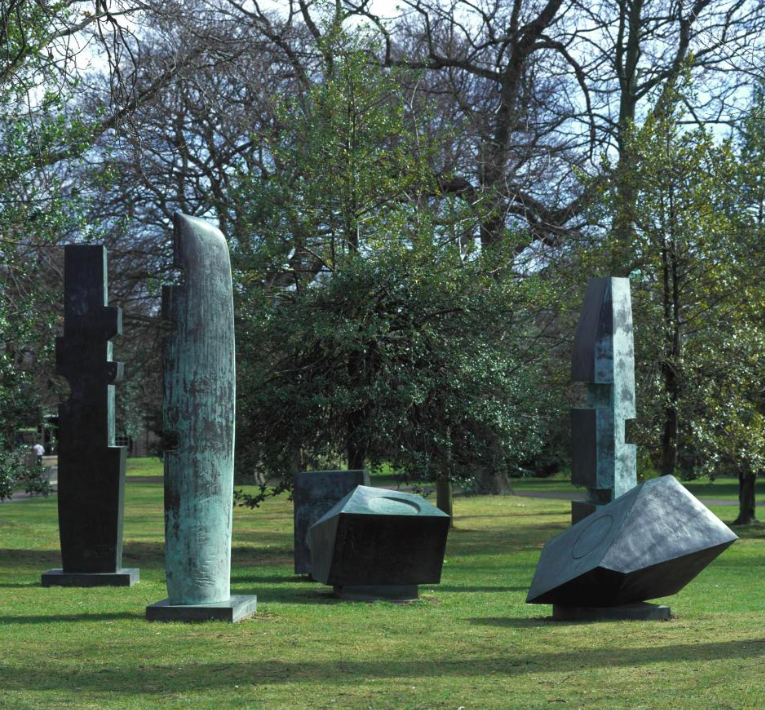Louise Bourgeois in 5 Artworks: Creepy, Crawly, and Brilliant
Louise Bourgeois was the artist behind the world-famous spider sculpture—Maman. Her career spanned decades, and her oeuvre often focused on complex...
Joanna Kaszubowska 25 November 2024
Barbara Hepworth’s 1973 bronze-cast sculpture Conversation with Magic Stones is mythic, mysterious, and interactive. Hepworth (1903–1975) was an English artist famous for her modernist sculptures.

Made up of six parts, Conversation with Magic Stones is in conversation with itself, with us, and with its surrounding landscape. Because it is a bronze cast, Conversation with Magic Stones is not a one-off sculpture – four identical castings exist. Dispersed across the world, one copy is in a private collection in Switzerland, another is at the Scottish National Gallery of Modern Art, one sits on the campus of Trinity University in San Antonio, Texas, USA, and the artist’s copy is owned by the Tate in London, UK.
Bronze-cast works are reproducible because their creation process involves a mold. Although identical copies of Conversation with Magic Stones exist, they are individualized by the space they occupy and the unique mythic character they invoke.

For example, the copy at Trinity University carries the myth that students who study alongside the magic stones will do better on an exam. In this way, students at Trinity University have assigned magical properties to the sculpture that suit its specific university setting.
Created in the last few years of Hepworth’s life, the sculpture consists of three tall, vertical forms which the artist described as “figures,” and three squatter, horizontal forms which she described as “stones”. Hepworth’s description of the vertical forms as “figures” suggests their anthropomorphism. Conversely, the identical eight-sided polyhedron “stones” could almost be mistaken for actual carved stones; Hepworth convincingly made what was once a liquid material look like organic rock.

The equal number of anthropomorphic figures and fixed stones balance the sculpture. For each figure, there is an accompanying stone. With each part’s distinct attributes in mind, the six parts of the sculpture interact in a unified conversation amongst themselves.

We as viewers are also included in this conversation – we can disrupt, confuse, and add to it. Hepworth would have wanted viewers to circumambulate, walkthrough, and even climb on the sculpture. The interactive possibilities and new perspectives are endless as the conversation is extended to the viewer.
The stones create their own space that you must enter into for the conversation to be whole. The “conversation” mentioned in the title of the work is ambiguous and abstract, however, in one sense, this is a conversation about space: how a human relates spatially to the sculpture and how parts of the sculpture interact with each other.

For Dore Ashton, writer, professor, and critic of modern and contemporary art, Hepworth’s Conversation with Magic Stones satisfies the desire for an origin story:
The stones I find in Hepworth – whether the bronze analogies in Conversation, or real stones – are nearly always the bones of the Earth Mother, carrying their ineffable message of origin. They subsume all of our longings for beginnings; for truths that escape pragmatics.
Dore Ashtone, quoted in “Conversation with Magic Stones,“ Tate.
In my mind, Conversation with Magic Stones, in conjunction with its various settings and its adopted myths, evokes a sense of knowledge — possessed or (more often than not) unpossessed. The stones have answers, although they tend to conjure up more questions. Nevertheless, the sculpture contains power in the hidden wisdom of its parts.
Author’s bio
DailyArt Magazine needs your support. Every contribution, however big or small, is very valuable for our future. Thanks to it, we will be able to sustain and grow the Magazine. Thank you for your help!